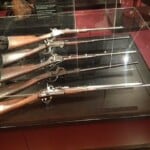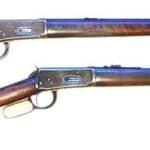
Introduction
The Mosin-Nagant rifle is one of the most recognizable and historically significant bolt-action rifles in the world. Known for its rugged reliability, long service life, and widespread use, the Mosin-Nagant has been a staple of military forces, particularly in Russia and the Soviet Union, for over a century. Its impact extends across multiple wars, continents, and military doctrines, making it one of the most produced and battle-tested firearms in history.
Origins and Development
The Mosin-Nagant rifle was developed in response to the rapid evolution of military firearms in the late 19th century. The introduction of smokeless powder had revolutionized small arms, rendering the older Berdan single-shot rifles of the Russian Army obsolete. Recognizing the need for a modern, repeating rifle, the Russian military sought a new design.
The competition to develop this new rifle featured designs from Sergei Ivanovich Mosin, a Russian army officer, and Léon Nagant, a Belgian arms designer. While both designs were tested extensively, the final adopted rifle was primarily Mosin's design, incorporating only a few elements from Nagant's submission. This decision was driven by national pride and a desire to keep the rifle development domestic. Officially designated the 3-Line Rifle Model 1891 ("трёхлинейная винтовка"), it was commonly referred to simply as the Mosin-Nagant.
Design and Features
The Mosin-Nagant featured a five-round internal magazine loaded via stripper clips, a bolt-action mechanism, and was chambered for the newly developed 7.62×54mmR cartridge. The use of a rimmed cartridge, while somewhat outdated compared to rimless designs used in other contemporary rifles, proved beneficial for extraction and reliability in extreme conditions.
Key features of the original M1891 included:
- Long barrel (31.6 inches) for enhanced accuracy
- Hexagonal receivers (early models)
- Straight bolt handle (later changed in sniper variants)
- Adjustable rear sight for long-range engagements
The rifle underwent several modifications over the years, leading to the introduction of improved models like the M91/30, M38, M44, and the highly regarded Finnish variants.
Manufacturing and Production
Production of the Mosin-Nagant began in 1891 at three major Russian arsenals: Tula, Izhevsk, and Sestroryetsk. However, during World War I, domestic production capacity was insufficient, leading Russia to contract Remington Arms and New England Westinghouse in the United States to produce additional rifles. Approximately 1.5 million rifles were manufactured by these American firms, though a significant number remained in the U.S. after the Russian Revolution of 1917, with many being sold on the civilian market or used by U.S. troops during the Allied intervention in Russia (1918-1920).
By World War II, the rifle had been further refined into the Mosin-Nagant M91/30, the most widely produced variant. It featured a round receiver (to ease production) and a shortened barrel for improved handling. During the war, millions of M91/30s were produced under wartime conditions, often with rougher finishes but maintaining reliability.
Additionally, Finland, having captured large numbers of Mosin-Nagants during the Winter War (1939-1940), extensively modified them into models such as the M27, M28, and M39, which were renowned for their superior craftsmanship and accuracy.
Service History: Wars and Global Influence
The Mosin-Nagant saw extensive use in multiple major conflicts:
World War I (1914-1918)
The Mosin-Nagant was the standard-issue rifle for the Imperial Russian Army, fighting on the Eastern Front. Production demands exceeded supply, leading to continued American production contracts. Many rifles from this era remained in service well into the next war.
Russian Civil War (1917-1922)
Both Red Army and White Army forces heavily relied on the Mosin-Nagant, leading to variations in condition and quality. The rifle’s durability proved crucial in the harsh conditions of the war.
World War II (1939-1945)
The Soviet Red Army used the Mosin-Nagant extensively during the war, with the M91/30 sniper variant playing a key role in Soviet sniper tactics. Legendary snipers like Vasily Zaitsev and Lyudmila Pavlichenko used Mosin-Nagant sniper rifles to deadly effect.
Cold War and Beyond
After World War II, the Mosin-Nagant was gradually replaced by semi-automatic and automatic weapons like the SKS and AK-47. However, surplus rifles were distributed across the Eastern Bloc, China, Vietnam, and Africa, seeing continued service in conflicts well into the 21st century, including the Afghan-Soviet War and the Syrian Civil War.
Performance and Ballistics
The 7.62×54mmR cartridge remains one of the most enduring military cartridges in history, still in use today in PKM machine guns and Dragunov sniper rifles.
Ballistic performance varies based on load and barrel length:
- Standard FMJ Load: 148-grain bullet, velocity of ~2,800 fps
- Sniper Load: 174-grain bullet, designed for greater accuracy at long range
- Effective Range: 500 meters (iron sights), 800-1,000 meters (with optics)
Compared to contemporaries like the Springfield M1903 (.30-06), Lee-Enfield (.303 British), and Mauser 98 (7.92×57mm), the Mosin-Nagant was robust but had a stiff bolt operation and slower cycling speed. However, its rugged design made it highly reliable in extreme conditions.
Comparison to Other Battle Rifles
| Rifle | Cartridge | Action | Capacity | Effective Range |
|---|---|---|---|---|
| Mosin-Nagant M91/30 | 7.62×54mmR | Bolt-action | 5 rounds | 500-1,000m |
| Springfield M1903 | .30-06 Springfield | Bolt-action | 5 rounds | 500-800m |
| Lee-Enfield SMLE | .303 British | Bolt-action | 10 rounds | 500-900m |
| Karabiner 98k | 7.92×57mm Mauser | Bolt-action | 5 rounds | 500-1,000m |
| M1 Garand | .30-06 Springfield | Semi-auto | 8 rounds | 500-1,000m |
While the Mosin-Nagant lacked the rapid cycling of the Lee-Enfield or the semi-auto firepower of the M1 Garand, its simplicity, ease of manufacture, and sheer durability made it one of the most successful rifles in history.
Legacy and Modern Use
The Mosin-Nagant remains highly sought after by collectors, shooters, and military historians. It is widely available on the surplus market, with many rifles still in use by guerrilla and militia forces worldwide. As an iconic piece of military history, it continues to be a favorite among enthusiasts for its durability, historical significance, and affordability.
Conclusion
Few rifles have had the global impact of the Mosin-Nagant. From the battlefields of World War I to present-day conflicts, this rifle has stood the test of time as a symbol of reliability, endurance, and firepower. Whether as a military weapon, a hunting rifle, or a collector’s item, the Mosin-Nagant’s legacy remains firmly entrenched in firearms history.
Read more here:
Discussions on the Mosin-Nagant can be found here:
If you know of any forums or sites that should be referenced on this listing, please let us know here.








